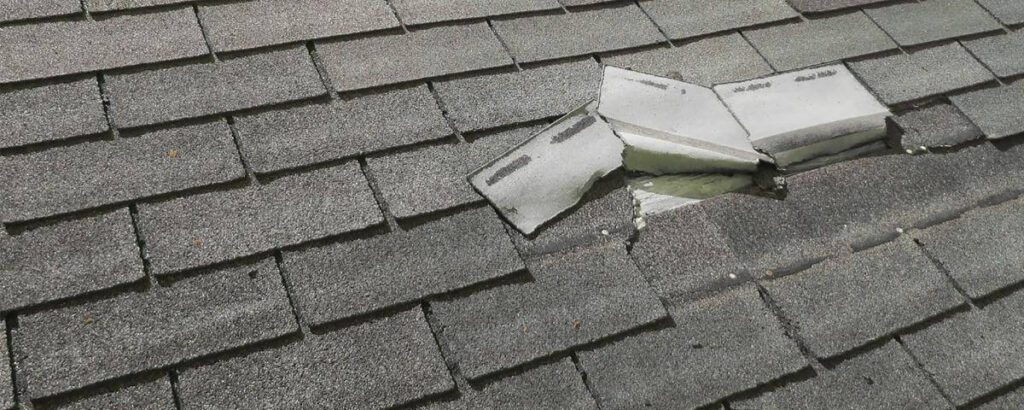Hail damage is extremely common in some parts of the U.S. and can lead to a significant amount of damage that can result in a roof replacement. It’s important to understand what to look for if you suspect your roof has suffered from hail damage to ensure you can immediately schedule the necessary repairs. Here is everything you need to know if your roof has hail damage.
What Does Hail Damage Look Like on a Roof?
It can be challenging to discover where hail damage has occurred on your roof if you don’t know where to look. You may notice several impressions that have formed on the asphalt shingles if the hail was more than one inch in size.
It’s also important to inspect other features on the roof like the flashing, gutters, and vents to determine if the materials have suffered from damage.
If you notice a lot of dimples that are present, it indicates the rest of your roof is likely damaged.
You don’t always have to access the roof to determine if hail damage is present. There are a few signs to look for while spending time on the ground if you suspect hail has affected the quality of your roof.
Here is a list of places to look for signs of hail damage:
- Dings and Dents to the exterior of your garage door
- Holes in your window screens
- Cracked or broken windows
- Dents on your mailbox
There may also be dents, spatter, or holes on your window shutters, house siding, and the electric meter on the outside of the home or building. If the materials and features have visible signs of damage, your roof requires an inspection and likely needs repairs.
Hail Damage Roof Insurance Claim
If a roofer discovers damage on your roof that require repairs, you’ll need to start the process of filing a claim with your homeowner’s insurance provider. Many homeowner’s insurance companies require a professional to perform an assessment to confirm if repairs are needed before they process the claim.
Filing a hail damage roof insurance claim requires submitting the dates of the damage. Although most companies give you up to a year to file a claim, it’s important to file it as soon as possible to avoid complications or delays. An insurance adjuster will visit the property and will also request that you receive a quote from a reputable roofing company in the local area.
After the claim is approved, you can move forward with the necessary repairs and will receive the initial payment for the repairs or roof replacement. Once the work is completed your contractor will notify the insurance company and the final claim payment will be released. Expect to pay your deductible and any additional work you may want done at the time.
When Does Hail Damage Occur?
The most common time of the year when hail damage occurs is between March and October when storms are present. Hail can still occur at different times of the year, especially if the weather patterns shift.
It develops when the freezing altitude of the air drops below 11,000 feet, which is common in the Midwest. The hailstorms begin to form when different layers of water begin to attach to each other in a large cloud. Frozen droplets start to be released from the cloud but can push back up due to the wind that is present.
Does Hail Damage Affect Different Materials Differently?
Not all roofing materials are impacted in the same way when they have contact with hail. One of the most common roofing materials that have a reputation for withstanding the impact of hail is asphalt shingles with a rating of Class 3 or 4, which is the highest Class rating.
Metal panels are also known to be resistant and are recommended in climates where hail is common. Even the largest hail has difficulty penetrating metal roofs, which contributes to their lifespan of 40 to 70 years.
Cedar shingles and shakes are also less likely to suffer from hail damage due to their durability. This type of roofing material has a high UL2218 rating.
Although slate panels have a higher price tag than other roofing materials in the industry, their density prevents hail from damaging the tiles easily. This allows slate tiles to last an average of 150 years before they begin to deteriorate.
Clay and concrete tiles are more likely to develop small and large fractures after hail has contact with the materials. The tiles can also break easily due to foot traffic.
Asphalt shingles with a lower class of 1 or 2 are also at a higher risk of suffering from damage because they have less durability with their construction. This can quickly lead to leaks if the necessary repairs aren’t performed by a professional.
Checking the hail-resistant rating of each roofing material can make it easier to determine if your roof will hold up well in the middle of a heavy storm.
Next Steps
If you want to learn more about hail damage and schedule a roof inspection from one of our professional roofers, contact us today.
We can answer your questions and can perform the necessary repairs to restore the quality of your roofing structure.
Every storm damage assessment from Vision Roofing is done by a licensed professional with experience in the insurance industry, so you get context around not just the damage, but what will likely be covered as well. Contact us online or by calling 704-312-8558 to schedule your hail damage inspection.


